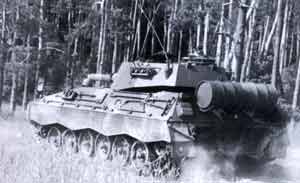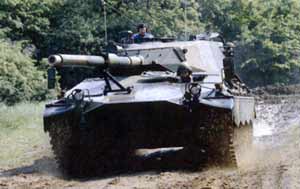| Designation: | TH 301 |
 |
|---|---|---|
| Manufacturer: | Henschel Wehrtechnik GmbH | |
| Product type: | Armoured Vehicles | |
| Name: | Main battle tank |
In mid-1974, the German company Thyssen Henschel (which recently became Henschel Wehrtechnik) was awarded a contract for the design and development of a new medium tank for the Argentine Army under the designation of the TAM (Tanque Argentino Mediano), as well as an infantry combat vehicle under the designation of the VCI (Vehiculo Combate Infanteria), subsequently renamed VCTP. The contract covered the design, development and construction of three prototypes of both the TAM and the VCI.
The first prototype of the TAM was completed in September 1976 with the second and third prototypes finished the following year. On completion of company trials in Germany the TAMs were shipped to Argentina for both operational and firing trials. Chassis construction and final assembly were carried out in Buenos Aires while construction of the turret and the integration of the gun and fire-control system took place at Rio Tercero. The total Argentine requirement was for 512 TAMs and VCTP infantry fighting vehicles, but production was completed after about 350 vehicles had been built. Additional information on the TAM programme is given in this section under Argentina.
In 1981, Malaysia signed a contract for 102 members of this family in three versions: MBT (Lion), armoured personnel carrier (Tiger) and armoured recovery vehicle (Elephant), but no deliveries were made.
The TH 301 was tested at the Thai Cavalry Centre in 1985-86, this being the first time that this vehicle had been tested in a non-NATO country. These trials included firing 130 rounds of German ammunition from the Rheinmetall 105 mm Rh 105-30 gun against both stationary and moving targets. The vehicle was fitted with an AEG/Telefunken fire-control system, FWM electrohydraulic gun-control system and with the main armament stabilised in both elevation and traverse, gunner's sight with laser range-finder, gyrostabilised panoramic telescope for the tank commander and PZB 200 passive LLLTV system over the main armament with screens for both the commander and gunner.
In early 1988, a TAM was trialled in Ecuador and a TH 301 was demonstrated in Malaysia, but by 1999 none of these trials had resulted in firm orders being placed.
Description
The chassis of the vehicle is based on the one used for the Marder 1 ICV used in large numbers by the German Army, but strengthened to take account of the increased weight of the vehicle and the stresses caused by firing the main armament.
The hull of the TH 301 is all-welded steel with the well-sloped glacis plate providing protection against small arms fire, shell splinters and armour-piercing rounds up to 40 mm in calibre.
The driver is seated at the front of the hull on the left side and steers the vehicle with a conventional steering wheel. He is provided with three periscopes and a single-piece hatch cover that opens to the right. Two escape hatches are provided, one in the floor of the vehicle and one at the hull rear.
The engine is mounted to the right of the driver with the glacis plate hinged on the right to allow access to the engine for maintenance. On the prototype the engine was identical to the one installed in the Marder 1 ICV and developed 600 hp at 2,200 rpm but production vehicles have a supercharged engine that develops 720 hp at 2,400 rpm. The engine is coupled to a Renk HSWL 204 planetary gearbox which gives four gears in both directions. The steering system is of the stepless hydrostatic type.
The all-welded turret is mounted to the rear of the vehicle with the commander and gunner on the right and the loader on the left. The commander is provided with a single-piece hatch cover and eight periscopes. Mounted in front of the hatch is a non-stabilised Steinheil Lear Siegler TRP-2A panoramic sight with a magnification of between x6 and x20, identical to that fitted to the Leopard 1 MBT and which can be replaced by a night sight. The commander also operates the coincidence range-finder. The gunner is seated forward and below the commander and is provided with a Zeiss TZF sight with a magnification of x8, combined with a swivelling and tilting periscope. The loader is provided with a single-piece hatch cover that opens to the rear with a tilting periscope mounted in front of him. An ammunition loading port is provided in the left side of the turret. Mounted in the hull rear is a hatch that can be used either as an emergency exit or to reload the vehicle rapidly with ammunition.
The torsion bar suspension system consists of six rubber-tyred roadwheels with the drive sprocket at the front, idler at the rear and three track-return rollers. The first, second, fifth and sixth roadwheel stations have hydraulic shock-absorbers. The tracks are by Diehl with removable rubber pads. The tops of the tracks are covered by detachable rubber skirts.
To extend the TAM's range two 200 litre long-range fuel tanks can be fitted at the rear. The basic vehicle can ford to a depth of 1.4 m but with preparation 2.25 m, or 4 m with a snorkel. Standard equipment includes an NBC system, a combustion heater for both cold engine starts and the crew compartment, electric bilge pumps and a fire extinguishing system that can be operated manually or automatically.
Main armament is a 105 mm rifled gun developed in Argentina, although the Rheinmetall Rh 105-30 can also be fitted. Both weapons fire all standard 105 mm tank ammunition. It is provided with a bore evacuator, a thermal sleeve and is fully stabilised in both planes. There are 50 rounds of 105 mm ammunition carried, 20 of which are in the turret. Mounted coaxially with the main armament is a 7.62 mm machine gun. A similar weapon is mounted on the roof of the tank for antiaircraft defence. Four Wegmann 76 mm smoke grenade dischargers are mounted on either side of the hull.
Optional equipment includes additional armour protection, radios and an intercom system.
- TH 301
Using company funds, Henschel Wehrtechnik has built a fourth prototype of the TAM called the TH 301 (this was originally called the TAM-4), which was completed late in 1978. Externally it is very similar to the model designed for Argentina but internally has significant differences in its power pack and fire-control system.
In addition to eight periscopes for all-round observation, the commander has a PERI-R12 sight as fitted to the final production model of the Leopard 1,the Leopard 1A4. This stabilised sight has an elevation of +60°, a depression of -10° and can be traversed through a full 360°. It has a magnification of x2 or x8 and is fitted with an external wiper.
The gunner has a fully stabilised periscope with a magnification of x8 and an integral laser range-finder. Additional vision equipment includes one periscope for the gunner and one periscope for the loader.
Its main armament is a Rheinmetall-developed 105 mm gun designated the Rh 105-30 firing all standard 105 mm tank rounds and with an elevation of +18° and depression of -7°. The turret can be traversed through a full 360° in 15 seconds and the main armament is fully stabilised in both planes.
Information on target range is fed to the computer manually by the gunner or automatically by the laser range-finder, which has a range of 400 to 5,000 m. Angle of cant and lead angle are also fed automatically and the type of ammunition to be fired is fed in manually.
For engaging targets at night there is an LLLTV camera mounted on the mantlet which moves in elevation with the main armament. Both the commander and gunner have one TV monitor screen and, in addition to the optical cross-hairs being displayed, a second set of electronically generated cross-hairs is superimposed on the TV picture. The latter changes in accordance with the variable angle of aim (independent of ammunition type and target range) and is also corrected for vehicle cant. The two sets of cross-hairs are then brought together and the main armament fired.
The TH 301 is powered by an MTU 833 Ka-500 diesel developing 750 hp coupled to a Renk HSWL 204 transmission which is fitted with a hydrodynamic retarder which is used to augment the steering effort and to brake the vehicle.
- 155 mm SPG
Argentina placed an order with Otobreda of Italy for 25 155 mm Palmaria turrets which will be installed on lengthened TAM chassis, with seven roadwheels either side instead of six. The turrets were delivered in 1986-87 with the first chassis being completed in Argentina in 1987. Full details of this are given in the Self-propelled guns and howitzers (tracked) section under Argentina. Recent information has indicated that this has entered service in small numbers.
Production complete in Argentina but can be undertaken in Germany or Argentina upon receipt of orders.
|
||||||||||||||||||||||||||||||||||||||||||||||||||||||||||||||||
|
||||||||||||
 |
 |
